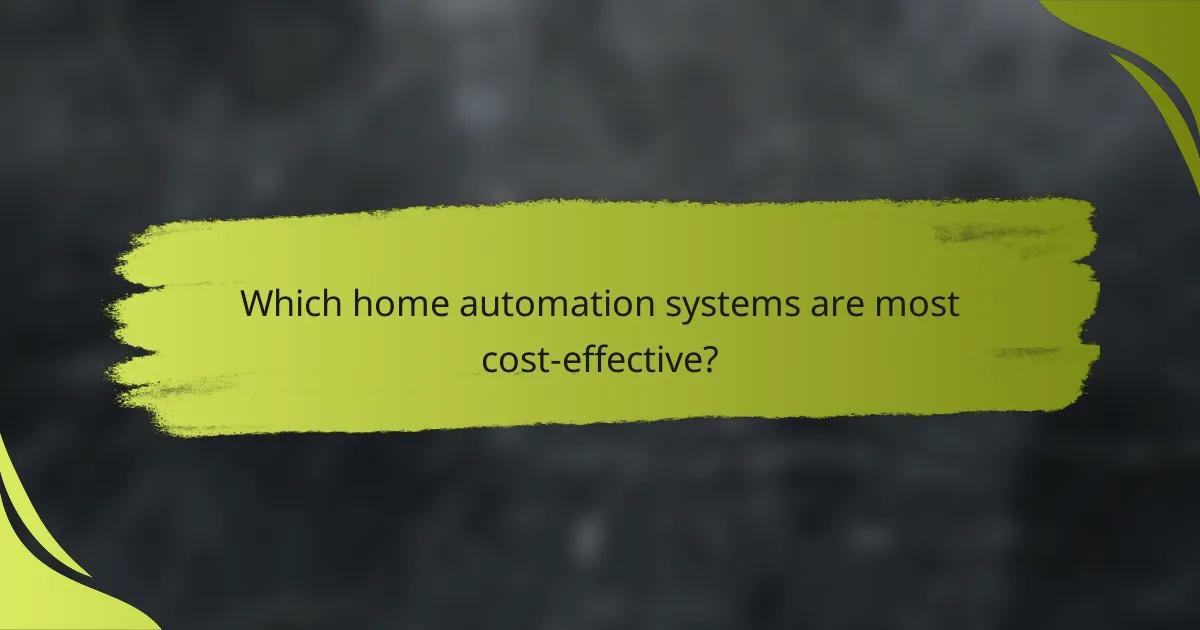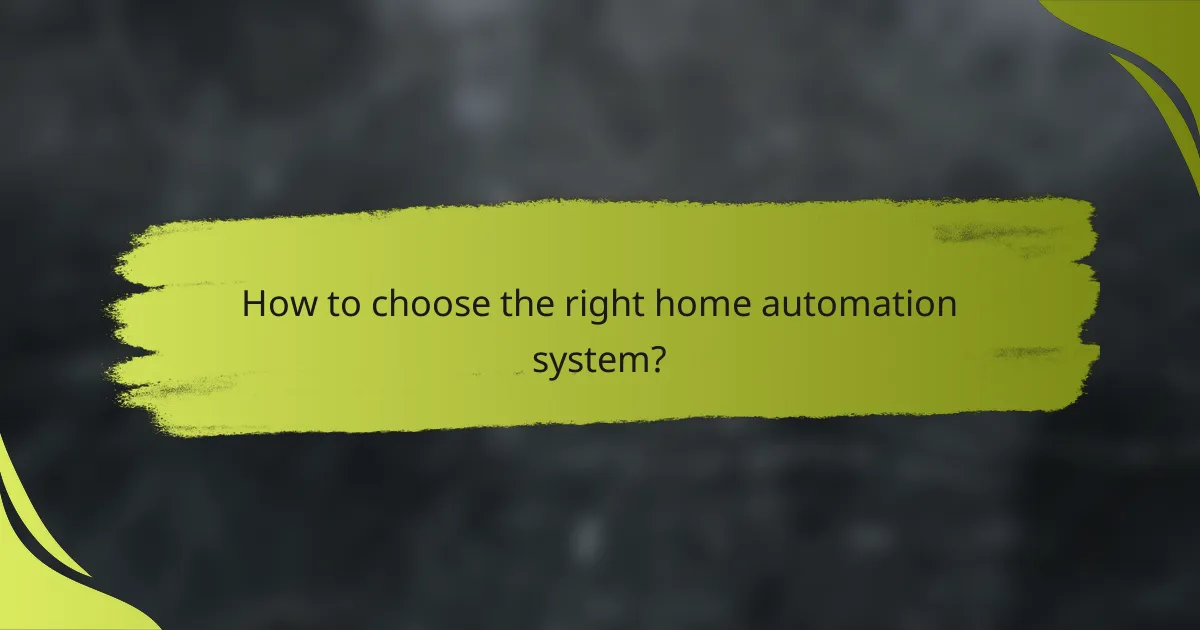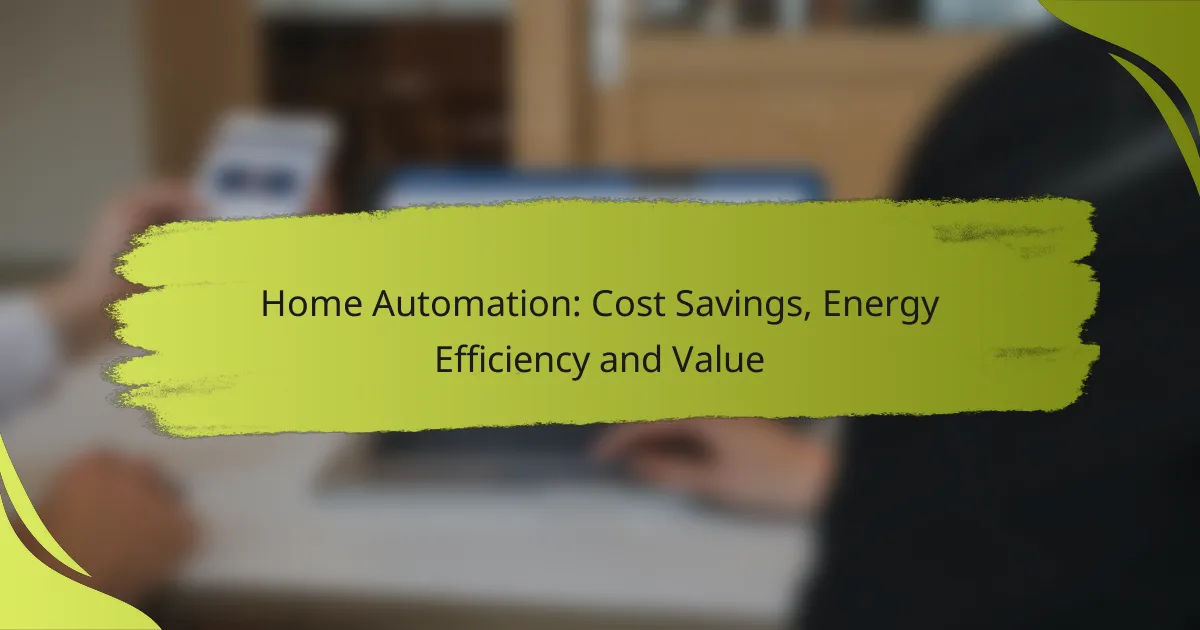Home automation presents an opportunity for homeowners to achieve significant cost savings and enhance energy efficiency. By utilizing smart technologies to optimize energy consumption and streamline maintenance, households can lower their utility bills while increasing property value. Affordable systems like Google Nest and Amazon Echo make it easier than ever to integrate these benefits into daily life.

How can home automation save costs in India?
Home automation can significantly reduce costs for homeowners in India by optimizing energy usage and minimizing maintenance expenses. By integrating smart technologies, households can enjoy lower utility bills and enhance the overall value of their property.
Reduced energy bills
Smart home systems can help manage energy consumption effectively, leading to reduced electricity bills. For instance, smart thermostats can adjust heating and cooling based on occupancy, potentially saving up to 20% on energy costs.
Additionally, automated lighting systems can turn off lights in unoccupied rooms, further decreasing energy usage. Homeowners can also monitor their energy consumption in real-time, allowing them to make informed decisions about usage patterns.
Lower maintenance costs
Home automation can lower maintenance costs by providing timely alerts for necessary repairs and routine maintenance. Smart sensors can detect leaks or unusual activity, allowing homeowners to address issues before they escalate into costly repairs.
Moreover, automated systems can schedule maintenance tasks, such as HVAC filter changes, ensuring that equipment runs efficiently and prolonging its lifespan. This proactive approach can save homeowners significant amounts over time.
Increased property value
Investing in home automation can enhance property value, making homes more attractive to potential buyers. Features like smart security systems, energy-efficient appliances, and automated lighting are increasingly sought after in the real estate market.
Research indicates that homes with smart technology can sell for higher prices compared to those without. Homeowners can expect a return on investment that ranges from 10% to 20% depending on the extent of automation implemented.

What energy efficiency benefits does home automation provide?
Home automation enhances energy efficiency by optimizing energy consumption through smart technology. By automating systems like heating, lighting, and monitoring, homeowners can significantly reduce waste and lower utility bills.
Smart thermostats
Smart thermostats adjust heating and cooling based on your schedule and preferences, ensuring that energy is used only when needed. Many models allow remote control via smartphone apps, enabling users to make real-time adjustments and track energy usage.
Consider models that learn your habits over time, potentially reducing heating and cooling costs by 10-15%. Look for features like geofencing, which adjusts settings based on your location, and energy reports that provide insights into usage patterns.
Automated lighting systems
Automated lighting systems can turn lights on and off based on occupancy and time of day, significantly cutting down on energy waste. These systems often include motion sensors and timers, ensuring lights are only active when necessary.
Installing LED bulbs in conjunction with automation can further enhance savings, as LEDs consume less energy than traditional bulbs. Homeowners can expect savings of up to 30% on lighting costs by using smart controls effectively.
Energy monitoring tools
Energy monitoring tools provide real-time data on energy consumption, helping homeowners identify areas for improvement. These devices can track usage patterns and suggest actionable steps to reduce waste.
Many energy monitors are compatible with smart home systems, allowing for integrated control and automation. Regularly reviewing this data can lead to informed decisions, such as adjusting appliance usage during peak hours to save on costs.

Which home automation systems are most cost-effective?
Cost-effective home automation systems typically offer a balance of functionality, ease of use, and affordability. Systems like Google Nest, Amazon Echo, and Philips Hue provide various features that can enhance energy efficiency and convenience without breaking the bank.
Google Nest
Google Nest offers a range of smart devices, including thermostats, cameras, and doorbells, that can be integrated into a cohesive home automation system. The Nest Learning Thermostat, for instance, can help save on energy bills by learning your schedule and adjusting heating and cooling accordingly.
Consider the initial investment versus long-term savings. While a Nest thermostat may cost around $200, users often see a reduction in energy costs of 10-15% annually, making it a worthwhile investment over time.
Amazon Echo
The Amazon Echo serves as a central hub for various smart home devices, allowing users to control lights, thermostats, and more through voice commands. The Echo Dot, priced around $50, is an affordable entry point for those looking to start automating their home.
When using Echo devices, ensure compatibility with your existing smart devices. This system can enhance convenience and potentially lower energy usage by enabling users to turn off lights and adjust appliances remotely.
Philips Hue
Philips Hue smart lighting offers customizable lighting solutions that can improve energy efficiency. With prices starting at around $15 per bulb, these LED lights can be controlled via smartphone or voice, allowing for scheduled on/off times that reduce energy consumption.
To maximize savings, consider using Philips Hue bulbs in conjunction with motion sensors or timers. This setup can ensure lights are only on when needed, further decreasing electricity costs over time.

What factors influence the cost of home automation in India?
The cost of home automation in India is influenced by several factors including initial setup costs, ongoing subscription fees, and installation complexity. Understanding these elements can help homeowners make informed decisions about their automation investments.
Initial setup costs
Initial setup costs for home automation can vary widely based on the technology and devices chosen. Basic systems may start from around INR 15,000 to INR 30,000, while more advanced setups with multiple devices can exceed INR 1,00,000. It’s essential to consider the quality and brand of devices, as well as any additional features that may be required.
When budgeting for initial setup, include costs for smart devices like lights, thermostats, and security systems. Additionally, consider whether you will need a central hub to manage these devices, which can add to the overall expense.
Ongoing subscription fees
Many home automation systems come with ongoing subscription fees for services such as cloud storage, advanced features, or technical support. These fees can range from INR 500 to INR 2,500 per month, depending on the service level and features included. It’s important to factor these costs into your long-term budget.
Some systems may offer free basic services, but premium features often require a subscription. Evaluate what features are essential for your needs to avoid unnecessary expenses.
Installation complexity
The complexity of installation can significantly impact the overall cost of home automation. Simple plug-and-play devices can be installed by homeowners without professional help, while more complex systems may require professional installation, which can add INR 5,000 to INR 20,000 to your total costs.
Consider the layout of your home and the existing infrastructure. If extensive wiring or modifications are needed, it may be more cost-effective to hire a professional. Always assess whether you have the skills and tools necessary for a DIY installation to avoid potential pitfalls.

How to choose the right home automation system?
Choosing the right home automation system involves evaluating compatibility with existing devices, user interface ease, and future scalability. A well-suited system enhances convenience, energy efficiency, and overall value in your home.
Assessing compatibility
Compatibility is crucial when selecting a home automation system. Ensure that the system can integrate with your current devices, such as smart lights, thermostats, and security cameras. Check for compatibility with popular protocols like Zigbee, Z-Wave, or Wi-Fi.
Before purchasing, review the manufacturer’s specifications and user reviews to confirm that the system works seamlessly with your existing technology. This will prevent future headaches and additional costs related to replacing incompatible devices.
Evaluating user interface
The user interface (UI) of a home automation system should be intuitive and user-friendly. A clear, easy-to-navigate app or control panel enhances your experience and encourages regular use. Look for systems that offer customizable dashboards and voice control options.
Consider testing the UI in-store or through online demos. A good UI should allow you to manage devices quickly and efficiently, reducing the learning curve and making automation a seamless part of your daily routine.
Considering scalability
Scalability refers to the ability to expand your home automation system as your needs change. Choose a system that allows for easy addition of new devices without significant upgrades or replacements. This flexibility is essential for adapting to future technology advancements.
When evaluating scalability, look for systems that support a wide range of devices and have a strong developer community. This will ensure that you can keep your home automation system up-to-date and aligned with your evolving preferences and requirements.

What are the local regulations for home automation in India?
In India, home automation regulations primarily focus on safety, energy efficiency, and compliance with building codes. These regulations can vary by state and municipality, so it’s essential to check local laws before implementing any automation systems.
Building codes
Building codes in India set the standards for construction and safety, which also apply to home automation systems. These codes ensure that electrical installations, including smart devices, meet specific safety requirements to prevent hazards like electrical fires or shocks.
When planning home automation, consult local building authorities to understand the applicable codes. For instance, wiring should comply with the Bureau of Indian Standards (BIS) specifications, ensuring that all installations are safe and reliable.
Additionally, consider energy efficiency regulations that may incentivize the use of smart technologies. Some states offer rebates or incentives for homes that install energy-efficient systems, which can help offset initial costs.
